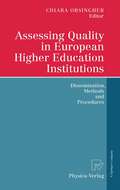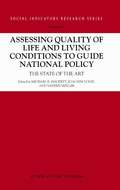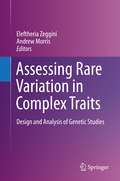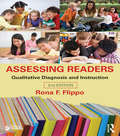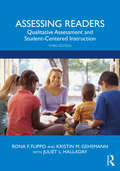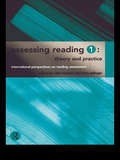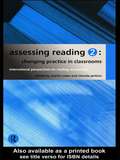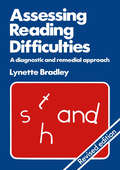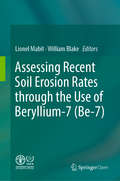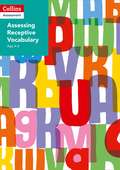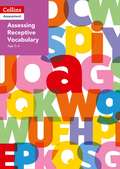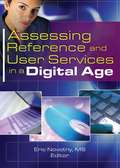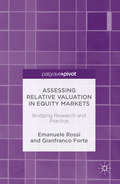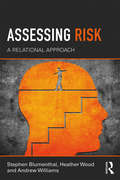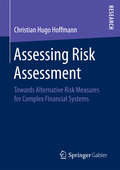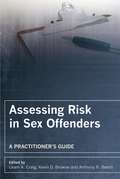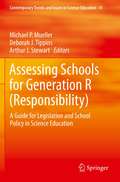- Table View
- List View
Assessing Quality in European Higher Education Institutions: Dissemination, Methods and Procedures
by Chiara OrsingherEuropean higher education institutions are facing in these last years a number of relevant political and social changes that have asked for more transparency, accountability, comparability and legitimacy of degrees. In light of these new challenges, the great majority of universities have responded by implementing quality assurance processes, either through evaluation or through accreditation. This book collects the evaluation and accreditation experiences gathered by higher education institutions in Finland, France, Germany, Italy, the Netherlands, Spain, the United Kingdom and Sweden. It provides a synthetic picture of the present state of quality assurance practices in Europe and offers a few lessons for a future European dimension of quality assurance.
Assessing Quality of Life and Living Conditions to Guide National Policy: The State of the Art (Social Indicators Research Series #11)
by ValerieMøller JoachimVogel Michael R. HagertyThis book is a useful "how to" book for researchers and government offices wanting to start or improve their own QOL survey, and contains "best practices" from all over the world. It is a valuable resource for researchers, policy and for those wishing to effect changes in public policy.
Assessing Race, Ethnicity and Gender in Health
by Sana LoueThis book deals specifically with the historical basis for use of terms in race, gender, ethnicity, sex and sexual orientation. It brings much needed clarity to the debate by identifying the ethical issues as well as the technical challenges inherent in measuring these elusive concepts. The author expands on her work begun in Gender, Ethnicity, and Health Research by paralleling the evolution of racial and sexual categories with the development of health research. In addition, the book provides a salient guide to assessment tools currently used in measuring racial and sexual constructs, identity, and experience.
Assessing Rare Variation in Complex Traits: Design and Analysis of Genetic Studies
by Eleftheria Zeggini Andrew MorrisThis book is unique in covering a wide range of design and analysis issues in genetic studies of rare variants, taking advantage of collaboration of the editors with many experts in the field through large-scale international consortia including the UK10K Project, GO-T2D and T2D-GENES. Chapters provide details of state-of-the-art methodology for rare variant detection and calling, imputation and analysis in samples of unrelated individuals and families. The book also covers analytical issues associated with the study of rare variants, such as the impact of fine-scale population structure, and with combining information on rare variants across studies in a meta-analysis framework.Genetic association studies have in the last few years substantially enhanced our understanding of factors underlying traits of high medical importance, such as body mass index, lipid levels, blood pressure and many others. There is growing empirical evidence that low-frequency and rare variants play an important role in complex human phenotypes. This book covers multiple aspects of study design, analysis and interpretation for complex trait studies focusing on rare sequence variation. In many areas of genomic research, including complex trait association studies, technology is in danger of outstripping our capacity to analyse and interpret the vast amounts of data generated. The field of statistical genetics in the whole-genome sequencing era is still in its infancy, but powerful methods to analyse the aggregation of low-frequency and rare variants are now starting to emerge.The chapter Functional Annotation of Rare Genetic Variants is available open access under a Creative Commons Attribution 4.0 International License via link.springer.com.
Assessing Readers: Qualitative Diagnosis and Instruction, Second Edition
by Rona FlippoA Co-publication of Routledge and the International Reading Association This new edition of Assessing Readers continues to bridge the gap between authentic, informal, and formative assessments, and more traditional quantitative, and summative assessment approaches. At the heart of the book is respect and confidence in the capabilities of knowledgeable teachers to make the correct literacy decisions for the students they teach based on appropriate assessments. Inclusive and practical, it supports individual classroom teachers' knowledge, beliefs, decisions, and roles and offers specific assessment, instruction, and organizational ideas and strategies, while incorporating a range of perspectives that inform the field of reading and literacy education, covering the most important ideas and information found in more traditional reading diagnosis books. Changes in the Second Edition Addresses the Common Core State Standards Includes Response to Intervention (RTI) Discusses family literacy in language-diverse homes and the needs of ELL students Covers formative assessment Offers ideas and guidelines for ELL assessment Looks at issues of accountability and teaching to prescribed state tests and objectives versus accommodating to them – the pitfalls and problems and how to cope Provides new practical examples, including new rubrics, more teacher-developed cognitive assessments, a new case study, and new teacher-developed strategy lessons
Assessing Readers: Qualitative Diagnosis and Instruction, Second Edition
by Rona FlippoA Co-publication of Routledge and the International Reading Association This new edition of Assessing Readers continues to bridge the gap between authentic, informal, and formative assessments, and more traditional quantitative, and summative assessment approaches. At the heart of the book is respect and confidence in the capabilities of knowledgeable teachers to make the correct literacy decisions for the students they teach based on appropriate assessments. Inclusive and practical, it supports individual classroom teachers' knowledge, beliefs, decisions, and roles and offers specific assessment, instruction, and organizational ideas and strategies, while incorporating a range of perspectives that inform the field of reading and literacy education, covering the most important ideas and information found in more traditional reading diagnosis books. Changes in the Second Edition Addresses the Common Core State Standards Includes Response to Intervention (RTI) Discusses family literacy in language-diverse homes and the needs of ELL students Covers formative assessment Offers ideas and guidelines for ELL assessment Looks at issues of accountability and teaching to prescribed state tests and objectives versus accommodating to them – the pitfalls and problems and how to cope Provides new practical examples, including new rubrics, more teacher-developed cognitive assessments, a new case study, and new teacher-developed strategy lessons
Assessing Readers: Qualitative Assessment and Student-Centered Instruction
by Rona F. Flippo Kristin M. Gehsmann Juliet L. HalladayThe third edition of Assessing Readers continues to bridge the gap between authentic, informal, and formative assessments and more traditional quantitative and summative assessment approaches. Designed to assist educators and reading specialists in making informed decisions about not only what to assess, but also how, it provides teachers with a menu of qualitative assessment options, encouraging them to consider their own values and beliefs in light of the goals they have for the students they teach. Building on nearly four decades of theory, research, and practice, it is up to date with current research and offers specific assessment, instruction, and organizational ideas and strategies. With an emphasis on comprehension, motivation and engagement, and developing strategic knowledge, Assessing Readers offers a road map for teachers trying to meet the demands of increasingly rigorous standards. Features include examples of student-centered assessment, ideas for organizing and managing differentiated instruction, sample lesson plans, and authentic case studies. Accessible and practical, the third edition empowers pre-service and in-service teachers alike, encouraging them to think about the importance of their assessment and instructional choices and supporting them with the tools they need to achieve their goals and meet the needs of all students. Changes in the Third Edition: A new focus on literacy development and developmentally responsive instruction Expanded coverage of emergent literacy and the assessment of foundational skills, including concepts about print, storybook reading, phonological and phonemic awareness, alphabet knowledge, and concept of word in text A new section on assessing vocabulary and morphological knowledge Expanded coverage of response to instruction/intervention (RTI) New information on assessment and instruction of culturally and linguistically diverse students Increased attention to issues of social justice, educational equity, and anti-bias practices
Assessing Readers: Qualitative Assessment and Student-Centered Instruction
by Rona F. Flippo Kristin M. Gehsmann Juliet L. HalladayThe third edition of Assessing Readers continues to bridge the gap between authentic, informal, and formative assessments and more traditional quantitative and summative assessment approaches. Designed to assist educators and reading specialists in making informed decisions about not only what to assess, but also how, it provides teachers with a menu of qualitative assessment options, encouraging them to consider their own values and beliefs in light of the goals they have for the students they teach. Building on nearly four decades of theory, research, and practice, it is up to date with current research and offers specific assessment, instruction, and organizational ideas and strategies. With an emphasis on comprehension, motivation and engagement, and developing strategic knowledge, Assessing Readers offers a road map for teachers trying to meet the demands of increasingly rigorous standards. Features include examples of student-centered assessment, ideas for organizing and managing differentiated instruction, sample lesson plans, and authentic case studies. Accessible and practical, the third edition empowers pre-service and in-service teachers alike, encouraging them to think about the importance of their assessment and instructional choices and supporting them with the tools they need to achieve their goals and meet the needs of all students. Changes in the Third Edition: A new focus on literacy development and developmentally responsive instruction Expanded coverage of emergent literacy and the assessment of foundational skills, including concepts about print, storybook reading, phonological and phonemic awareness, alphabet knowledge, and concept of word in text A new section on assessing vocabulary and morphological knowledge Expanded coverage of response to instruction/intervention (RTI) New information on assessment and instruction of culturally and linguistically diverse students Increased attention to issues of social justice, educational equity, and anti-bias practices
Assessing Reading 1: Theory and Practice
by Colin Harrison Terry SalingerThis book, along with its companion volume Assessing Reading 2: Changing Practice in Classrooms, was originally conceived as the major outcome from an international seminar on reading assessment held in England. It focuses particularly on theoretical and methodological issues, though with a clear series of links to practices in assessment, especially state and national approaches to classroom-based assessment in the USA, the UK and in Australia, at both primary and secondary levels. Chapters offer new perspectives on the theories that underlie the development and interpretation of reading assessments, national assessments and classroom-based assessment, challenging readers to think in different ways.
Assessing Reading 1: Theory and Practice (International Perspective On Reading Assessment Ser.)
by Colin Harrison Terry SalingerThis book, along with its companion volume Assessing Reading 2: Changing Practice in Classrooms, was originally conceived as the major outcome from an international seminar on reading assessment held in England. It focuses particularly on theoretical and methodological issues, though with a clear series of links to practices in assessment, especially state and national approaches to classroom-based assessment in the USA, the UK and in Australia, at both primary and secondary levels. Chapters offer new perspectives on the theories that underlie the development and interpretation of reading assessments, national assessments and classroom-based assessment, challenging readers to think in different ways.
Assessing Reading 2: Changing Practice In Classrooms : International Perspectives On Reading Assessment (International Perspective On Reading Assessment Ser.)
by Martin Coles Rhonda JenkinsThis second book focuses directly on the classroom, on the challenges individual teachers face in classroom-based assessment, and how these challenges have been and are being met in a range of international contexts.
Assessing Reading 2: Changing Practice in Classrooms
by Martin Coles Rhonda JenkinsThis second book focuses directly on the classroom, on the challenges individual teachers face in classroom-based assessment, and how these challenges have been and are being met in a range of international contexts.
Assessing Recent Soil Erosion Rates through the Use of Beryllium-7 (Be-7)
by Lionel Mabit William BlakeThis open access book is the first comprehensive guideline for the beryllium-7 (Be-7) technique that can be applied to evaluate short-term patterns and budgets of soil redistribution in agricultural landscapes. While covering the fundamental and basic concepts of the approach, this book distinguishes itself from other publications by offering step-by-step instructions on how to use this isotopic technique effectively. It covers experimental design considerations and clear instruction is given on data processing. As accurate laboratory measurement is crucial to ensure successful use of Be-7 to investigate soil erosion, a full chapter is devoted to its specific determination by gamma spectrometry. This open access contribution further describes new developments in the Be-7 technique and includes a concluding chapter highlighting its potential benefits to support the implementation of area-wide soil conservation policy.
Assessing Receptive Vocabulary Age 4–5 (PDF)
by Clare DowdallClose the word gap with 30 colourful illustrated word lists for reception and early years. Use popular and curriculum topics flexibly as matching pairs, pre-teach activities or on word walls. Send the vocabulary lists home to encourage discussion and topic knowledge. Check for understanding with half termly tests. 300 illustrated words grouped by topic give children a rich, relevant vocabulary that will support their learning.
Assessing Receptive Vocabulary Age 5–6 (Collins Assessment Ser.)
by Clare DowdallClose the word gap with 30 colourful illustrated word lists for Year 1. Use popular and curriculum topics flexibly as matching pairs, pre-teach activities or on word walls. Send the vocabulary lists home to encourage discussion and topic knowledge. Check for understanding with half termly tests. 300 illustrated words grouped by topic give children a rich, relevant vocabulary that will support their learning.
Assessing Reference and User Services in a Digital Age
by Eric NovotnyEffectively assess whether any library is making good use of the reference/user service resources available todayLibraries need to develop standards by which they can assess their individual performances in a larger context, and Assessing Reference and User Services in a Digital Age makes significant contributions to this ongoing discussion. The book addresses its subject matter via approaches ranging from case studies of individual libraries to general discussions of best practices. The contributors explore the impact of the Internet on the field of evaluation, focusing on electronic reference and instruction. They highlight current issues, present research results, and offer expert advice on how to assess online reference and instruction. All chapters are well referenced to facilitate further study, and many include tables, appendixes, checklists, and other helpful features that make difficult information easy to access and understand.The chapters that make up Assessing Reference and User Services in a Digital Age are as rich and varied as the backgrounds of their authors. Experienced researchers provide the results of studies conducted to determine the nature and effectiveness of the online reference services offered by various libraries. Practitioners and administrators from different institutional settings (academic libraries, public libraries, consortiums, etc.) provide their perspectives on the issues facing librarians who need to assess the electronic services they provide.In this important new book: Andrew Briedenbagh shows how a chat service can be implemented and suggests which data should be collected for it Buff Hirko examines VET: the Virtual Evaluation Toolkit Ruth Vondracek shares the experiences of a university library as it entered a statewide e-reference consortium, and offers advice and issues to consider before entering such a partnership librarians from San Jose State University present a model for evaluating electronic reference services that can be used in public or academic libraries Kathleen Kern discusses holistic evaluation chat transcripts are addressed in several chapters, including Joseph Fennewald&’s comparisons of question categories, Lesley Moyo&’s analysis of the use of instruction in the virtual environment, and Caleb Tucker-Raymond&’s proposed set of quality measures for chat reference Laurie Probst and Michael Pelikan report on the use of a "Tell Us What You Think" button to gather user feedback Kristi Nelson and Catherine L. Ross examine a research study that asked library school students to submit a reference question online and report on their experiences Melissa Gross, Charles McClure, and R. David Lankes suggest measures to determine the cost and benefits of a virtual reference service librarians from Utah State University describe the development of their online instructional moduleAssessing Reference and User Services in a Digital Age is designed as essential reading for library administrators, public service librarians, and researchers. It provides general advice for practitioners as well as an examination of research results and methodological issues. We urge you to consider making it part of your professional or teaching collection today.
Assessing Reference and User Services in a Digital Age
by Eric NovotnyEffectively assess whether any library is making good use of the reference/user service resources available todayLibraries need to develop standards by which they can assess their individual performances in a larger context, and Assessing Reference and User Services in a Digital Age makes significant contributions to this ongoing discussion. The book addresses its subject matter via approaches ranging from case studies of individual libraries to general discussions of best practices. The contributors explore the impact of the Internet on the field of evaluation, focusing on electronic reference and instruction. They highlight current issues, present research results, and offer expert advice on how to assess online reference and instruction. All chapters are well referenced to facilitate further study, and many include tables, appendixes, checklists, and other helpful features that make difficult information easy to access and understand.The chapters that make up Assessing Reference and User Services in a Digital Age are as rich and varied as the backgrounds of their authors. Experienced researchers provide the results of studies conducted to determine the nature and effectiveness of the online reference services offered by various libraries. Practitioners and administrators from different institutional settings (academic libraries, public libraries, consortiums, etc.) provide their perspectives on the issues facing librarians who need to assess the electronic services they provide.In this important new book: Andrew Briedenbagh shows how a chat service can be implemented and suggests which data should be collected for it Buff Hirko examines VET: the Virtual Evaluation Toolkit Ruth Vondracek shares the experiences of a university library as it entered a statewide e-reference consortium, and offers advice and issues to consider before entering such a partnership librarians from San Jose State University present a model for evaluating electronic reference services that can be used in public or academic libraries Kathleen Kern discusses holistic evaluation chat transcripts are addressed in several chapters, including Joseph Fennewald&’s comparisons of question categories, Lesley Moyo&’s analysis of the use of instruction in the virtual environment, and Caleb Tucker-Raymond&’s proposed set of quality measures for chat reference Laurie Probst and Michael Pelikan report on the use of a "Tell Us What You Think" button to gather user feedback Kristi Nelson and Catherine L. Ross examine a research study that asked library school students to submit a reference question online and report on their experiences Melissa Gross, Charles McClure, and R. David Lankes suggest measures to determine the cost and benefits of a virtual reference service librarians from Utah State University describe the development of their online instructional moduleAssessing Reference and User Services in a Digital Age is designed as essential reading for library administrators, public service librarians, and researchers. It provides general advice for practitioners as well as an examination of research results and methodological issues. We urge you to consider making it part of your professional or teaching collection today.
Assessing Relative Valuation in Equity Markets: Bridging Research and Practice
by Emanuele Rossi Gianfranco ForteThis book addresses the gap between the widespread use of stock market multiples in valuation practice and the frontiers of research on multiples. The book's approach is twofold: the authors first analyse the performance of multiples metrics in predicting the market price of a set of liquid and highly traded US stocks. The authors then employ these results to test profitable stock purchasing strategies employed in order to 'beat the market'. The results presented widen our understanding of the “market performances” of the valuation tools practitioners utilise in their everyday work. The evidence is of interest to researchers and equity analysts, who wish to analyse the circumstances in which valuation errors using multiples are more frequent and when market multiples become ineffective in estimating market prices.
Assessing Risk: A Relational Approach
by Stephen Blumenthal Heather Wood Andrew WilliamsAssessing Risk: A Relational Approach offers the practitioner a novel framework for understanding the complex and subtle issues involved in assessing and managing risks related to violence and sexual offending. The authors draw on their considerable experience working with high risk individuals in assessment and treatment. They have for many years consulted to practitioners in forensic mental health services and the criminal justice system and taught renowned courses at the Tavistock and Portman NHS Foundation Trust. This book outlines a comprehensive model of risk which draws on mainstream empirical research, threat assessment, developmental psychopathology, attachment theory, and a relational model derived from psychoanalysis. The framework incorporates intrapersonal and interpersonal dimensions and is designed to enhance the reader’s capacity to make a thorough risk formulation. The approach highlights the significance of childhood development in understanding violent and sexually violent acts, and the complicated interpersonal processes involved in managing individuals who have a propensity to violent enactment. These dynamic processes between people impact on risk and risk perception, and can distort judgement if not recognised and understood. Assessing Risk will be of practical use in enhancing the skills of professionals to assess and manage risk in a comprehensive and effective way, and will appeal to all those mental health and criminal justice practitioners working with risky individuals.
Assessing Risk: A Relational Approach
by Stephen Blumenthal Heather Wood Andrew WilliamsAssessing Risk: A Relational Approach offers the practitioner a novel framework for understanding the complex and subtle issues involved in assessing and managing risks related to violence and sexual offending. The authors draw on their considerable experience working with high risk individuals in assessment and treatment. They have for many years consulted to practitioners in forensic mental health services and the criminal justice system and taught renowned courses at the Tavistock and Portman NHS Foundation Trust. This book outlines a comprehensive model of risk which draws on mainstream empirical research, threat assessment, developmental psychopathology, attachment theory, and a relational model derived from psychoanalysis. The framework incorporates intrapersonal and interpersonal dimensions and is designed to enhance the reader’s capacity to make a thorough risk formulation. The approach highlights the significance of childhood development in understanding violent and sexually violent acts, and the complicated interpersonal processes involved in managing individuals who have a propensity to violent enactment. These dynamic processes between people impact on risk and risk perception, and can distort judgement if not recognised and understood. Assessing Risk will be of practical use in enhancing the skills of professionals to assess and manage risk in a comprehensive and effective way, and will appeal to all those mental health and criminal justice practitioners working with risky individuals.
Assessing Risk Assessment: Towards Alternative Risk Measures for Complex Financial Systems
by Christian Hugo HoffmannChristian Hugo Hoffmann undermines the citadel of risk assessment and management, arguing that classical probability theory is not an adequate foundation for modeling systemic and extreme risk in complex financial systems. He proposes a new class of models which focus on the knowledge dimension by precisely describing market participants’ own positions and their propensity to react to outside changes. The author closes his thesis by a synthetical reflection on methods and elaborates on the meaning of decision-making competency in a risk management context in banking. By choosing this poly-dimensional approach, the purpose of his work is to explore shortcomings of risk management approaches of financial institutions and to point out how they might be overcome.
Assessing Risk in Sex Offenders: A Practitioner's Guide
by Leam A. Craig Kevin D. Browne Anthony R. BeechAssessing Risk in Sex Offenders: A Practitioner's Guide is a handy resource for forensic practitioners responsible for assessing an managing sexual offenders at risk of recidivism. It covers the risk factors associated with sexual recidivism, evaluates risk assessment approaches and offers guidance on how to conduct forensic evaluations. Written by an expert author team, Assessing risk in Sex Offenders: A Practitioner's Guide examines: The characteristics of sexual offenders Methodological considerations in measuring predictive accuracy Static and dynamic factors Structured risk assessments Treatment of sexual offenders Policy and practices Assessing Risk in Sex Offenders: A Practitioner's Guide is an essential resource for clinical and forensic psychologists, forensic psychiatrists, undergraduate and postgraduate students in forensic and clinical psychology, and prison and probation officers.
Assessing Schools for Generation R: A Guide for Legislation and School Policy in Science Education (Contemporary Trends and Issues in Science Education #41)
by Michael P. Mueller Deborah J. Tippins Arthur J. StewartToday’s youth will face global environmental changes, as well as complex personal and social challenges. To address these issues this collection of essays provides vital insights on how science education can be designed to better engage students and help them solve important problems in the world around them.Assessing Schools for Generation R (Responsibility) includes theories, research, and practices for envisioning how science and environmental education can promote personal, social, and civic responsibility. It brings together inspiring stories, creative practices, and theoretical work to make the case that science education can be reformed so that students learn to meaningfully apply the concepts they learn in science classes across America and grow into civically engaged citizens. The book calls for a curriculum that equips students with the knowledge, skills, attitudes and values to confront the complex and often ill-defined socioscientific issues of daily life.The authors are all experienced educators and top experts in the fields of science and environmental education, ecology, experiential education, educational philosophy, policy and history. They examine what has to happen in the domains of teacher preparation and public education to effect a transition of the youth of America. This exciting, informative, sophisticated and sometimes provocative book will stimulate much debate about the future direction of science education in America, and the rest of the world. It is ideal reading for all school superintendents, deans, faculty, and policymakers looking for a way to implement a curriculum that helps builds students into responsible and engaged citizens.
Assessing Science Understanding: A Human Constructivist View (Educational Psychology)
by Joel J. Mintzes James H. Wandersee Joseph D. NovakRecent government publications like "Benchmarks for Scientific Literacy" and "Science for all Americans" have given teachers a mandate for improving science education in America. What we know about how learners construct meaning--particularly in the natural sciences--has undergone a virtual revolution in the past 25 years. Teachers, as well as researchers, are now grappling with how to better teach science, as well as how to assess whether students are learning. Assessing Science Understanding is a companion volume to Teaching Science for Understanding, and explores how to assess whether learning has taken place. The book discusses a range of promising new and practical tools for assessment including concept maps, vee diagrams, clinical interviews, problem sets, performance-based assessments, computer-based methods, visual and observational testing, portfolios, explanatory models, and national examinations.
